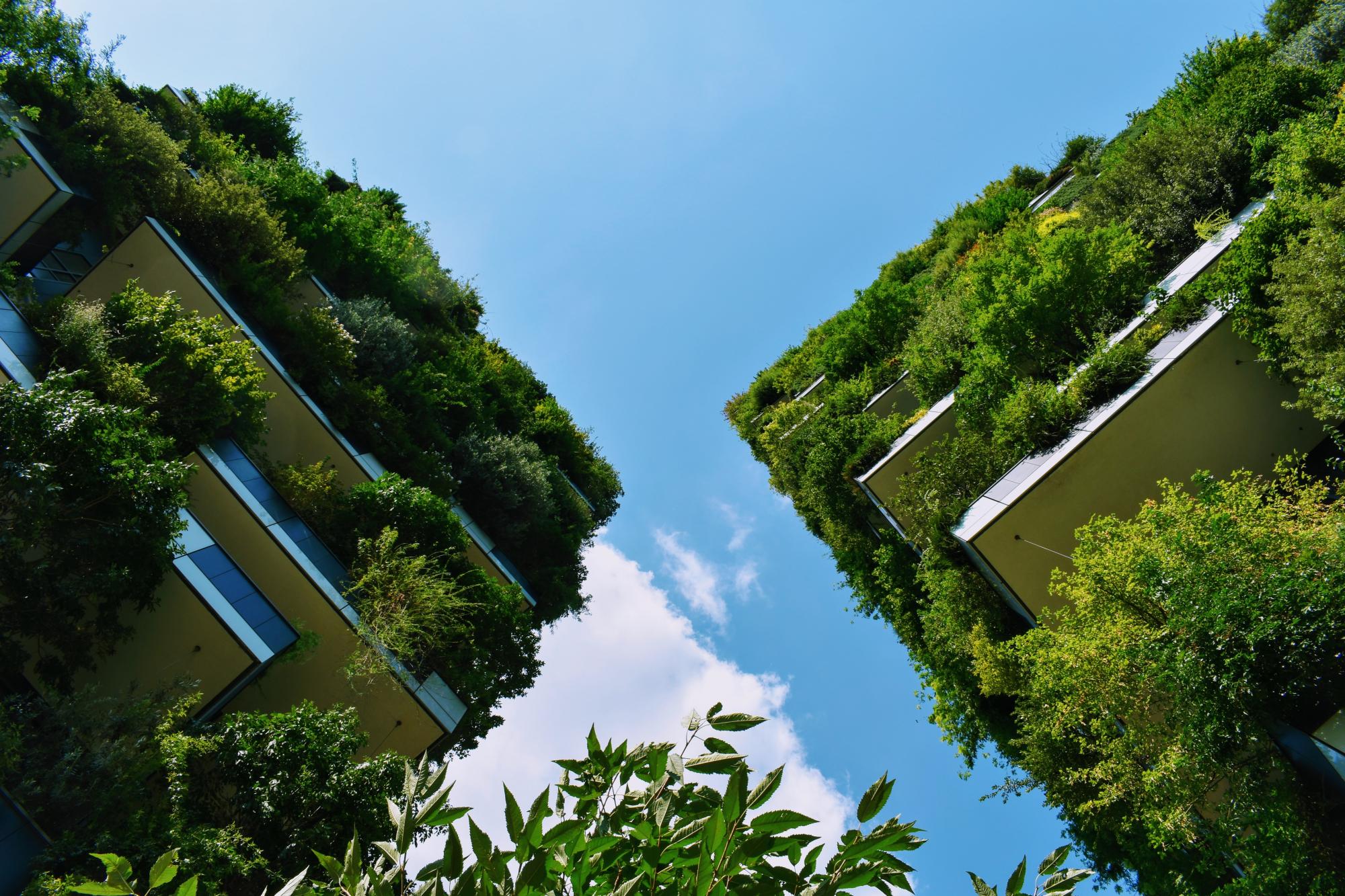Last updated: October 2021
The 53 square meters large green wall can be found in an office building in the center of Budapest. (Reference 9) It helps to balance the humidity indoors, cleans the air and provides a comfortable work environment. The project includes rainwater collection for the irrigation of the green wall. (Reference 6) The building itself was the first one in Central-Eastern Europe to gain the double environmental certification of BREEAM Very Good and LEED Gold. (Reference 9) The focus of the NBS are the indoor green walls, but the building itself also features vegetation on multiple terraces and sun collectors. (Reference 10)
Overview
Nature-based solution
- Nature in buildings (indoor)
- Green walls and ceilings
- Atriums/Courtyards
Key challenges
- Environmental quality
- Air quality improvement
- Health and well-being (SDG 3)
- Improving mental health
Focus
Creation of new green areas
Project objectives
The goal of implementing the green walls was to balance humidity inside the building and to produce oxygen, thus creating a comfortable atmosphere to work in. (Reference 1)
Implementation activities
As part of the development of the office building, two 12 m wide and 3,5 m high green walls were implemented that overall size is 53 square meter. The investors planted tropical plant species that are common in Hungary in indoor areas and species with a high degree of air purification effect. (Reference 1)
The green walls are watered automatically with greywater that is collected to irrigate the green walls and to manage stormwater.
Main beneficiaries
- Private sector/Corporate/Company
- Other
Governance
Management set-up
- Led by non-government actors
Type of initiating organisation
- Private sector/corporate actor/company
Participatory approaches/ community involvement
- Unknown
Details on the roles of the organisations involved in the project
Two companies worked together for the refurbishment of the building. The development was carried out by Horizon Development, the construction work was carried out by DVM Group. (Reference 6)
Project implemented in response to ...
... an EU policy or strategy?
Unknown
... a national policy or strategy?
Yes
(- Étv. (Építési törvény - Building Code): 1997. évi LXXVIII. tv. 62.
- OTÉK (Országos Településrendezési és Építési Követelmények - National Building Regulations): 253/1997. (XII. 20.) Kormány rendelet)
... a local policy or strategy?
Unknown
Financing
Total cost
Unknown
Source(s) of funding
- Corporate investment
Type of funding
- Direct funding (grants, subsidies, or self-financed projects by private entities)
Non-financial contribution
Unknown
Impacts and Monitoring
Environmental impacts
- Environmental quality
- Improved air quality
- Water management and blue areas
- Improved stormwater management
Economic impacts
- Attraction of business and investment
Socio-cultural impacts
- Unknown
Type of reported impacts
Expected impacts, Achieved impacts
Presence of formal monitoring system
Unknown
Presence of indicators used in reporting
No evidence in public records
Presence of monitoring/ evaluation reports
No evidence in public records
Availability of a web-based monitoring tool
No evidence in public records
References
1. DVM Design Kft. (2014). Az év zöldfala pályázat: Eiffel Palace Irodaház. [image] Available at: Source link. [Accessed: 19.06.2020].
2. Gelesz, A. (2014). Az Eiffel Palace irodaház. Építészfórum. [online] Available at: Source link [Accessed: 19.06.2020].
3. Source link. (2017). BREEAM. [online] Available at: Source link [Accessed: 19.06.2020].
4. Source link. (2017). LEED V4. [online] Available at: Source link [Accessed: 19.06.2020].
5. Source link. (2014). Eiffel Palace Irodaház: Az Év Legzöldebb Projektje 2014 - I. helyezett. [online] Available from: Source link [Accessed: 19.06.2020].
6. Source link., (2017). Eiffel Palace's Official Website: The Building. [online] Available at: Source link. Accessed: 19.06.2020].
7. Source link., (2017). Eiffel Palace's Official Website: Gallery. [image] Available at: Source link. [Accessed: 19.06.2020].
8. Source link. (2017). The Official Website of Green Fortune. [online] Available at: Source link. [Website unavailable in 2020].
9. Source link. (2014) Eiffel Palace, Budapest. [online]. Available at: Source link [Accessed: 14.07.2020]
10. Source link. (year unknown). Sustainability. Available at: Source link [Accessed: 14.07.2020]
2. Gelesz, A. (2014). Az Eiffel Palace irodaház. Építészfórum. [online] Available at: Source link [Accessed: 19.06.2020].
3. Source link. (2017). BREEAM. [online] Available at: Source link [Accessed: 19.06.2020].
4. Source link. (2017). LEED V4. [online] Available at: Source link [Accessed: 19.06.2020].
5. Source link. (2014). Eiffel Palace Irodaház: Az Év Legzöldebb Projektje 2014 - I. helyezett. [online] Available from: Source link [Accessed: 19.06.2020].
6. Source link., (2017). Eiffel Palace's Official Website: The Building. [online] Available at: Source link. Accessed: 19.06.2020].
7. Source link., (2017). Eiffel Palace's Official Website: Gallery. [image] Available at: Source link. [Accessed: 19.06.2020].
8. Source link. (2017). The Official Website of Green Fortune. [online] Available at: Source link. [Website unavailable in 2020].
9. Source link. (2014) Eiffel Palace, Budapest. [online]. Available at: Source link [Accessed: 14.07.2020]
10. Source link. (year unknown). Sustainability. Available at: Source link [Accessed: 14.07.2020]


